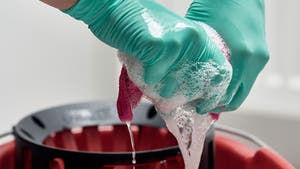From Outside In: 6 Tips for Minimizing the Risk of Bringing COVID-19 Home After Your Shift
With COVID-19 showing no signs of slowing, there is a serious and growing pressure put on essential workers on the front lines. These individuals are putting themselves at risk to ensure that others have access to healthcare, food and transportation during this pandemic, and that essential public spaces are clean and disinfected.

These essential workers have a lot of their minds right now. They are worried about their patients and their communities — how widespread is COVID-19, who is coming through their doors, will they be able to help them? They are worried about their own health — what if I’m exposed to a COVID-19 patient, will I have adequate PPE to protect me, what if I contract COVID-19? And they are worried about their families — are they putting loved ones at home at risk of exposure, are they bringing SARS-CoV-2 (the virus that causes COVID-19) back home with them after a shift, what can they do to protect their families?
As a career nurse turned infection preventionist, I’ve spent years on the front lines of healthcare studying epidemiology and seeking to understand how to stop the spread of disease. Much of what I learned in hospitals can be applied back in the home as an after-work routine during this pandemic.
Based on my experience and understanding, here are six actions professionals on the front lines can consider taking to minimize the risk of bringing the virus that causes COVID-19 back into their homes.
- Change clothes and shoes before leaving work. Consider changing out of your clothes and shoes before leaving work and avoid wearing these items into any public spaces you stop in on your way home (e.g., grocery store, restaurant, etc.) after your shift. Place your soiled clothes in a bag, preferably a disposable or launderable bag, and perform hand hygiene. Choose a pair of shoes to dedicate for work only. These shoes should remain at work.
- Perform hand hygiene as you exit work. By now, we are well aware of proper hand washing techniques, but don’t forget to also use some hand sanitizer, as recommended by the CDC, as you exit the workplace.
- When you get home, wipe down anything inside of your car. Use a disinfecting wipe to properly disinfect hard, nonporous surfaces within your car including cup holders, steering wheel, door handles, seat buckles and radio knobs where permitted by with manufacturer’s instructions. Items you may bring out of the home — purses, backpacks — should also be disinfected or washed upon entering the home.1
- Wash your work clothes. Without shaking out your soiled laundry, place your used work clothes in the washer and perform hand hygiene. Wash and dry your used work clothes separately at a higher temperature (100 to 135 degrees) for at least 30 minutes to ensure sufficient killing of germs.1 Use bleach (1/2 cup per load), if possible. Dry on hottest dryer setting. You should not re-wear any clothing (including jeans, sweaters, sweatshirt, etc.) until after it has been laundered.2 There are companies, like Prime Medical, that make scrubs and lab coats for medical personnel that not only are fade-resistant to bleach but after washing with bleach they are activated to provide antimicrobial protection while you wear them. Consider these for your next pair of scrubs.
- Jump in the shower. Not only can a nice hot shower provide the perfect respite after a hard day, but this ensures any viruses that have come home with you on your skin are physical removed and washed down the drain.
- Disinfect high-touch surfaces in your home. Using disinfecting wipes, regularly disinfect things like your cell phone, door knobs, light switches, remote controls, desks, bathroom fixtures, etc. And wash your hands after disinfecting.
While we all want to help protect those we love most when returning home at the end of the day, it’s also important to stay rooted in the facts as we decide how far to take these actions. As you consider making changes to your returning-home routine, keep a few things in mind:
- COVID-19 disproportionately impacts adults. While some infants and children have been sickened with COVID-19, adults make up most of the known cases to-date.3
- Transmission of coronavirus occurs much more commonly through respiratory droplets than through fomites (i.e., surfaces and clothing), but early evidence suggests that SARS-CoV-2 may remain viable from several hours to several days depending on the surface type and viral load on the surface.4 More studies are needed to confirm these survival times.
- Avoid sharing personal items such as dishes, towels, and bedding with family members, and change your linens weekly.
- While COVID-19 is primarily spread by the respiratory droplets from symptomatic persons, there is evidence that supports that transmission can occur even when individuals are not displaying symptoms.5 So, if you live with a high-risk6 individual (someone over 60 years old or with a chronic medical condition such as heart, lung disease, or diabetes), you may wish to social distance from each other until this crisis passes. I’ve heard of essential workers choosing to stay in separate parts of the home (including use of separate bathrooms if available), and sometimes even separate homes.
- Monitor yourself and your household contacts daily for signs and symptoms of COVID -19, including a temperature of 100.4 or greater and dry cough.7 Should you develop signs and symptoms consistent with COVID-19 or test positive, follow the CDC guidance on “What to do if you are sick”, and “Preventing the Spread of Coronavirus Disease 2019 in Homes and Residential Communities.”
General infection control measures should be on everyone’s list. Here are a few that those in your household can and should be following8:
- Frequent hand hygiene
- Covering coughs/sneezes
- Regular cleaning and disinfection of high-touch surfaces, including the bathroom
- Social distancing, avoiding persons who are ill and staying home when you are sick
- Eating a healthy diet, getting plenty of rest, and managing anxiety/stress.
A heartfelt thanks to all of you hard-working, selfless essential workers out there aiding and supporting us from the frontline. In these uncertain times with this continuously evolving situation we can only control that which we can. I sincerely hope that you find these tips helpful to protect yourself and your loved ones at home.
For the latest information on COVID-19 and variants, visit our CloroxPro COVID-19 Hub.
References
- According to Mary Gagliardi, aka “Dr. Laundry,” Clorox’s in-house scientist and cleaning expert.
- Centers for Disease Control and Prevention. (2020). Detailed Disinfection Guidance. Retrieved on 3/27/2020 from https://www.cdc.gov/coronavirus/2019-ncov/prepare/cleaning-disinfection.html
- Centers for Disease Control and Prevention. (2020). COVID-19 Frequently Asked Questions. Retrieved on 3/26/2020 from https://www.cdc.gov/coronavirus/2019-ncov/faq.html?CDC_AA_refVal=https%3A%2F%2Fwww.cdc.gov%2Fcoronavirus%2F2019-ncov%2Fprepare%2Fchildren-faq.html#anchor_1584387482747
- National Institute for Health. (2020). New coronavirus stable on surfaces for hours. Retrieved on 3/26/2020 from https://www.nih.gov/news-events/news-releases/new-coronavirus-stable-hours-surfaces
- Centers for Disease Control and Prevention. (2020). COVID-19: Healthcare Professionals: Frequently Asked Questions and Answers. Retrieved on 3/26/2020 from https://www.cdc.gov/coronavirus/2019-ncov/hcp/faq.html
- Centers for Disease Control and Prevention. (2020). COVID-19: People who are at higher risk for severe disease. Retrieved on 3/26/2020 from https://www.cdc.gov/coronavirus/2019-ncov/specific-groups/people-at-higher-risk.html
- Centers for Disease Control and Prevention. (2020). COVID-19: Symptoms for Coronavirus. Retrieved on 3/26/2020 from https://www.cdc.gov/coronavirus/2019-ncov/symptoms-testing/symptoms.html
- Centers for Disease Control and Prevention. (2020). COVID-19: How to Protect Yourself. Retrieved on 3/26/2020 from https://www.cdc.gov/coronavirus/2019-ncov/prepare/prevention.html


